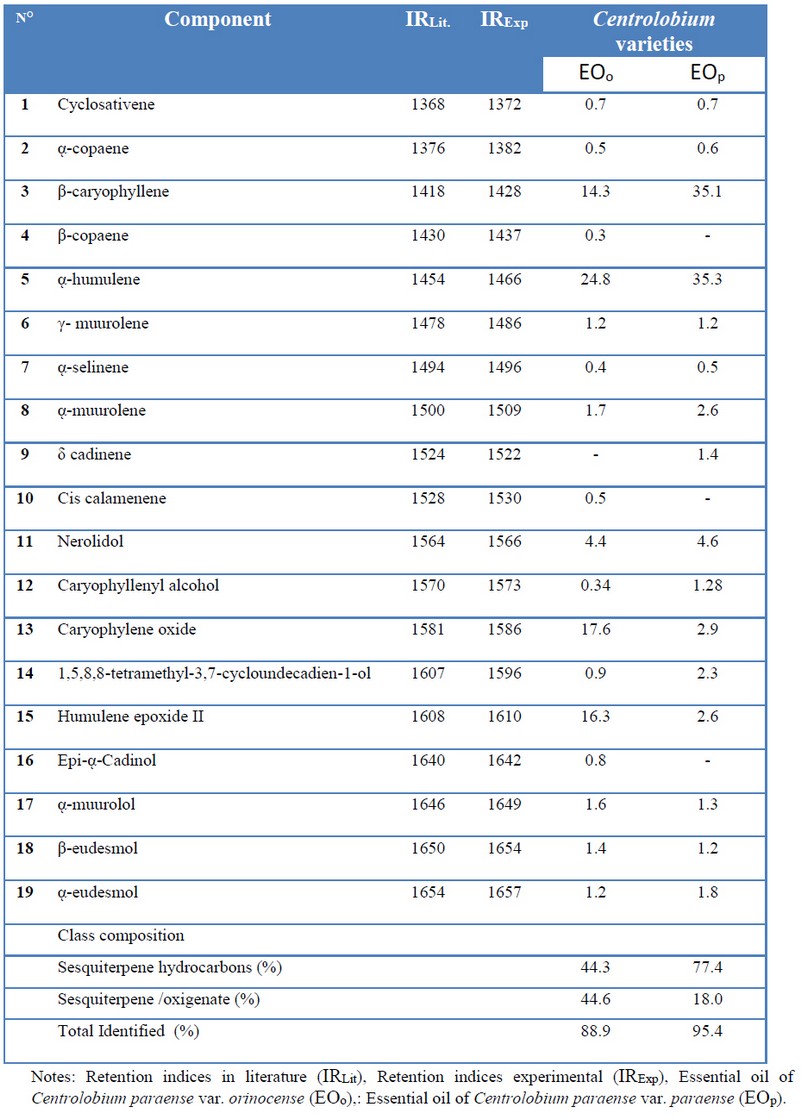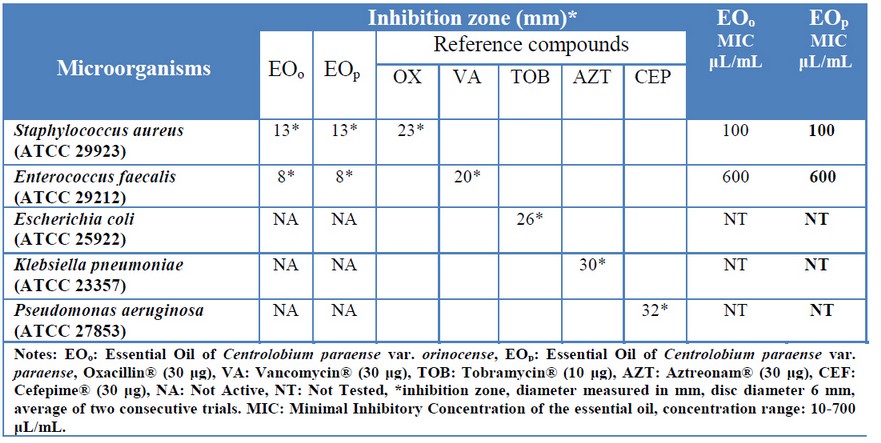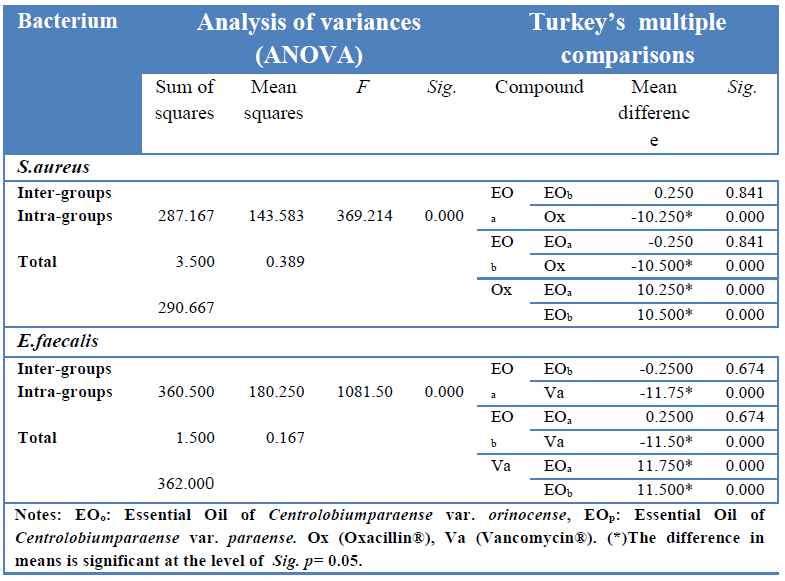2019.04.03.5
Files > Volume 4 > Vol 4 No 3 2019
INVESTIGATION / RESEARCH
Chemical diversity and antibacterial activity of volatile compounds from two Centrolobium paraense Tul. varieties.
Jesús E. Velásquez1*, Luis B. Rojas-Fermín2, Judith Velasco3, Rosa L. Aparicio2, Alfredo N. Usubillaga2, Elio Sanoja4.
Available from: http://dx.doi.org/10.21931/RB/2019.04.03.5
ABSTRACT
This work presents a comparative study of the chemical composition of the essential oils obtained from two varieties of Centrolobium paraense (orinocense EO o and paraense EO p) from Venezuela. GC analyzed the oils, and the constituents were identified by GC-MS and retention indices. Eighteen compounds were identified in EO o, which made up 88.9 % of the oil, but only sixteen compounds were identified in EO p, which made up 95.5 % of the total oil. β-caryophyllene (35.1 %) and -humulene (35.3 %) are the main constituents of EO p. The main constituents of EO o are α-humulene (24.8 %), β-caryophyllene (14.3 %), caryophyllene oxide (18.33 %), and humulene epoxide II (16.86 %). The biological activity of both oils was assayed. They were found to be equally active against Staphylococcus aureus and Enterococcus faecalis, with MIC of 100 and 600 μL/mL respectively. This is the first report describing the chemical composition of the essential oil of these species and their antibacterial activity.
Keywords: antibacterial activity, caryophyllene oxide, Centrolobium paraense, essential oil, humulene epoxide II, α-humulene, β-caryophyllene.
INTRODUCTION
The neotropical genus Centrolobium Mart. ex Benth (Leguminosae, Papilionoideae) comprises seven trees species: C. robustum, C. microchaete, C. tomentosum, C. ochroxylum, C. sclerophyllum, C. paraense, and C. yavizanum which grow in Brasil, Bolivia, Ecuador, Peru, Colombia, The Guianas, Panama, Trinidad and Venezuela between 50 and 350 meters above sea level. Some Centrolobium species are highly valued because of their enduring and beautiful wood, which has an orange-yellow color with dark red or black stripes1. In Venezuela Centrolobium paraense is the only Centrolobium species that have been described, which is popularly known as “cartán” or “Colorado”.
Because its wood is highly appreciated C. paraense has been overexploited to the point that it is becoming scarce and it is considered to be in danger of extinction according to the ideas presented on the book “Libro Rojo de la Flora Venezolana”2. Since research on this valuable tree is very scarce it was considered convenient to start a research program in order to devise methods to increase its population.
Two varieties have been identified within this species: C. paraense var. paraense and C. paraense var. orinocense. Taxonomic differences between both varieties are difficult to establish, mainly regarding the shape of the leaves at their base and the amount of indument at their surface 1, 3.
Previous studies on the secondary metabolites present on the wood of Centrolobium species, (C. paraense included), reported diarylheptanoids and isoflavonoides such as centrolobol, centrolobine and methylcentrolobine4, 5, 6, 7. Our laboratory is making an overall study of C. paraense, which includes physico-chemical and anatomical aspects of its wood 8, 9. Since no reports have been found on the chemical composition of the essential oil of the leaves, we have obtained, by hydrodistillation, the essential oils from the leaves of both varieties and compare their compositions. At the same time, their possible biological activity against human pathogens has been tested.
MATERIAL AND METHODS
Plant material
Fresh aerial parts of C. paraense var. orinocense and paraense (laminar portion) were collected in May 2014, from plants growing wild in similar environmental conditions near to Upata locality, state Bolívar, Venezuela at 345 m above sea level. Dr. Elio Sanoja made botanical identification. Voucher specimens were deposited at the MERF herbarium, Faculty of Pharmacy, University of Los Andes Merida, Venezuela (Luis Beltrán Rojas 063 and 064 paraense and orinocense respectively). The extraction conditions were identical for both species.
Isolation of essential oils
Aerial parts of both varieties were collected separately from random points on the trees under investigation. Leaves laminar portion (300 g) from each variety were separated and subjected to hydrodistillation in a Clevenger-type apparatus for 4h. The quantity of essential oil was measured directly in the extraction burette of the apparatus and content (%) was calculated as volume (mL) of essential oil per 100 g of plant material (v/w %). The oil sample was dried over sodium sulfate (Na2SO4), and stored in a dark vial at 4ºC until they were analyzed chromatographically.
Gas Chromatography GC: analyses were performed using a Perkin-Elmer Autosystem gas chromatography equipped with an FID detector and data-handling system. A 5 % phenylmethyl polysiloxane fused-silica capillary column was used (30 m x 0.25 mm i.d., film thickness 0.25 m; HP-5, Hewlett-Packard, CA, USA). The oven temperature was programmed from 60 °C to 260 °C, rising at 4 °C/min. The injector and detector temperatures were 200 °C and 280 °C, respectively. The carrier gas was helium at 0.8 mL/min. The sample (1.0 µL) was injected using a split ratio of 10:1. Retention indices were calculated concerning C8-C24 n-alkanes. The percentage composition of the oil was calculated by the normalization method from the GC peak areas. The percentage composition of the oil was calculated by the normalization method from the GC peak areas.
Gas chromatography-mass spectrometry: GC-MS analyses were carried out on a Model 5973 Hewlett-Packard GC-MS system fitted with an HP- 5MS fused silica column (30 m x 0.25 mm i.d., film thickness 0.25 µm, Hewlett-Packard). The oven temperature program was the same as that used for the HP-5 column for GC analysis; the transfer line temperature was programmed from 60 °C to 260 °C; rising at 4 °C/min, source temperature, 230 °C; quadrupole temperature 150 °C; carrier gas, helium adjusted to a linear velocity of 34 cm/s; ionization energy, 70 eV; scan range, 40 to 500 amu; 3.9 scans/s. Sample (1.0 µL) was injected using a Hewlett-Packard ALS injector with a split ratio of 50:1. The identity of the oil components was established from their GC retention indices, by comparison of their MS with those of standard compounds available in the laboratory, and by a library search (Nist 05 and Wiley MS Data Library, 6th edn) 10,11
Antimicrobial Assay
The antibacterial activity and minimum inhibitory concentration (MIC) were evaluated by the agar disk diffusion method described by Velasco et al. (2007)12. The bacterial strains used in experiments were as follows: Staphylococcus aureus (ATCC 25923), Enterococcus faecalis (ATCC 29212), Escherichia coli (ATCC 25992), Pseudomonas aeruginosa (ATCC 27853) and Klebsiella pneumoniae (ATCC 23357). Every bacterial inoculum was spread over plates containing Mueller-Hinton agar and a paper filter disc (6 mm) saturated with 10 μL of essential oil and then incubated at 37 ºC for 24 h. Positive control was also assayed to check the sensitivity of the tested organisms using the following antibiotics: Oxacillin®, Vancomycin®, Tobramycin®, Cefepime® and Aztreonam®. The minimal inhibitory concentration (MIC) was determined only with microorganisms that displayed inhibitory zones. MIC was determined by dilution of the essential oil in dimethyl sulphoxide (DMSO) by pipetting 10 μL of each dilution onto a filter paper disc. Dilutions of the oil within a concentration range of 10-350 μg/mL were also carried out.
Statistical analysis
Data obtained from antibacterial activity were expressed as mean values. The statistical analyses were carried out employing one way ANOVA, results with P <0.05 were considered to be statistically significant. A statistical package (SPSS version 19.0) was used for the data analysis.
RESULTS AND DISCUSSION
The results reported here on the essential oil chemical compositions of these varieties grow in Venezuela are novel, and show an interesting chemical diversification. Gas chromatographic analyses of both essential oils tested showed different composition. The yields of essential oil from orinocense (EOo) and paraense (EOp) were in the range of 0.25 - 0.22 %, respectively. EOp showed a yellowish oil, and EOo was a colorless oil. The identified components, percentages composition, and their Retention indices (RI) values listed in order of elution time on the HP 5 capillary column are reported in Table 1. A total of eighteen compounds were identified in the oil of the orinocense variety, which represents 88.9% of the oil. In the case of the paraense variety only sixteen constituents were identified, which in this case, represented 95.5 % of the total oil.

Table 1. Chemical composition of the essential oil (%) of two varieties of Centrolobium paraense from Venezuela.
All the identified compounds from the essential oil from both varieties were sesquiterpenes. The main constituents of the paraense variety were β-caryophyllene (35.1 %) and α-humulene (35.1 %), which, with the contribution of other six minor constituents add up to the total sesquiterpene hydrocarbon fraction (77.4 %). Eight minor constituents, which account for 18.0% of the paraense variety oil, are oxygenated sesquiterpenes, being nerolidol (4.6 %) the most abundant one. In the oil of the orinocense variety, α-humulene (24.8 %), β-ββ (14.3 %) were the most abundant sesquiterpene hydrocarbons, the contribution of other seven minor compounds added up to a total sesquiterpene hydrocarbon fraction of 44.3 %. Oxigenated sesquiterpenoids made, in this case 44.6 % of the oil. Caryophyllene oxide (17.6 %) and humulene epoxide II (16.3 %) were the most abundant oxygenated sesquiterpenes in the oil of the orinocense variety, which along with seven other minor oxygenated constituents made a total oxygenated sesquiterpene fraction of 44.7 %.
In spite of this fact, both oils are different because the paraense variety contains 77.4 % of hydrocarbon sesquiterpenes and only 18 % of oxygenated sesquiterpenes. On the other hand, the orinocense variety oil contains the same proportion of hydrocarbon sesquiterpenes (44.3%) and oxygenated sesquiterpenes (44.6 %). β-caryophyllene and α-humulene, the compounds that dominate the hydrocarbon fraction of both oils, are twice as abundant in the paraense variety oil. On the other hand caryophyllene oxide and humulene epoxide II are six times more abundant in the oxygenated fraction of the orinocence variety oil than in the paraense variety oil. Finally ᾳ-copaene, cis calamenene, and Epi-ᾳ-Cadinol, which are minor constituents of the orinocense variety, are not present in the paraense variety oil. On the other hand δ cadinene , a minor constituent of the paraense variety oil is absent from the orinocense oil.
Table 2 shows the results obtained from the antibacterial evaluation of both essential oils (EOo and EOp). The results revealed that the oil possessed antibacterial activity with varying magnitudes towards different strains. The essential oils were active only against S. aureus and E. faecalis and completely ineffective against E. coli, K. pneumoniae and P. aeruginosa. This behavior is possible because Gram-negative bacteria are less susceptible to essential oils than the Gram-positive strains because the former possess an outer membrane surrounding the cell membrane which restricts the diffusion of hydrophobic compounds through its lipopolysaccharide covering13.

Table 2. Antibacterial activity of essential oils of two varieties of Centrolobium paraense from Venezuela.
Biological activity of both oils was statistically superior (P<0.05) on the bacterial growth of S. aureus compared with E. faecalis with inhibition halos of 13 mm and 8 mm, respectively (Table 2). The MIC value of the oils was 100 μL/mL on S. aureus and 600 μL/mL against E. faecalis. These results suggest that the oils were more active against S. aureus. Although both oils (EOo and EOp) possess different chemical composition, the antimicrobial activity of the essential oils did not show statistically significant differences (p=0.841) against S. aureus (Table 3). Similar behavior was observed on E. faecalis (P=0.674). The statistical analysis indicated that the inhibitory effect of the essential oils against the two bacteria tested was in most cases not as strong as that of the reference compounds. (Oxacillin® and Vancomycin® respectively).

Table 3. ANOVA and Turkey’s multiple comparisons of biological activity of essential oils of Centrolobium (EOo, EOp), against S. aerus and E. faecalis.
The abundance, interaction mechanism, and presence of several reactive chemical components in the essential oils of both varieties, could have applications in the pharmaceutical and chemical industries. Previous investigations have shown that individual compounds detected in the essential oil of C. paraense show important biological activity. For example, β-caryophyllene has anti-inflamatory, anticarcinogenic, antibiotic, antioxidant, and local anesthetic activities14. The α-humulene showed anticancer activity15, anti-inflammatory effects16 and mixed with con β-caryophyllene increases its cytotoxicity against human tumour cell lines in vitro14. Nerolidol has an impact on the protein prenylation, and it can reduce adenomas in rats17. Caryophyllene oxide in combination with other sesquiterpenes showed higher anticancer activity against several cancer cell lines as human lung carcinoma, human colon adenocarcinoma, human leukemia cancer, human cervical adenocarcinoma, human gastric cancer, and human stomach cancer 18, 19, 20. The specific antibacterial activity of both oils on the tested microorganisms could be attributed to its high sesquiterpene content and the synergistic and antagonistic effects of these compounds. However, further studies are needed to obtain a better understanding of their biological activity.
CONCLUSION
This article is the first report on the differences in the chemical composition of the essential oil of these two varieties of Centrolobium paraense and their antibacterial activity, information that could be used with chemotaxonomic purposes in this genus. Results suggest that essential oils from both varieties of C. paraense could contribute to the control of infections caused by S. aureus and E. faecalis.
Acknowledgments
The authors thank the financial support of Consejo de Desarrolllo Científico, Humanístico, Tecnológico y de las Artes of Universidad de Los Andes (CDCHTA-ULA, Project: FA-578-15-08-A), to Fondo Nacional de Ciencia y Tecnología (FONACIT), Caracas, Venezuela (Pem 2001001639) and PROVITA Caracas, Venezuela (2008-17).
REFERENCES
1. Pirie m., klitgaard b., pennington r. (2009). revision and biogeography of centrolobium (leguminosae - papilionoideae). systematic botany 34 (2): 345–359. doi.org/10.1600/036364409788606262
2. Ilamozas s., de stefano r., meier w.; riina r., stauffer f., aymard g., huber o., ortiz r. (2003). libro rojo de la flora venezolana. edit., fundación polar, provita, fundación instituto botánico de venezuela. caracas, venezuela http://www.lrfv.org/libro-rojo-de-la-flora-venezolana
3. Rudd v. (1999). centrolobium (fabaceae). in flora of the venezuelan guayana. edit., p. berry, k. yatskievych, b. holst, volume 5, eriocaulaceae–lentibulariaceae. missouri botanical garden press u.s.a. p 269-271.
4. Craveiro a., prado a., gottlieb o., de albuquerque a. (1970). diarylheptanoid of centrolobium species. phytochemistry 9 (8): 1869-1875. doi.org/10.1016/s0031-9422(00)85606-x
5. Jurd l., wong r. (1984). diarylheptanoid and other phenolic constituents of centrolobium species. austrian journal of chemistry 37(5): 1127-1133. doi.org/10.1071/ch9841127
6. Alegrio l., braz r., gottlieb o. (1989). diarylheptanoids and isoflavonoids from centrolobium species. phytochemistry 28(9):2359-2362. doi.org/10.1016/s0031-9422(00)97984-6
7. Araujo c., alegrio l., leon l. (1998). antileishmanial activity of compounds extracted and characterized from centrolobium sclerophyllun. phytochemistry 49(3): 751-754. doi.org/10.1016/s0031-9422(97)00976-x
8. Velásquez j., toro m., rojas l., encinas o. (2006). actividad antifúngica de los extractivos naturales de especies latifoliadas de la guayana venezolana. madera y bosques 12 (1):51-61. doi.org/10.21829/myb.2006.1211250
9. Morgado r., gutiérrez l., garcía p., arrioja t., toro m., gómez l., velásquez j. (2010). variación longitudinal del peso especifico en la madera de centrolobium paraense tul. (fabaceae). revista forestal venezolana 54 (1), 227-234. https://www.thefreelibrary.com/variacion+longitudinal+del+peso+especifico+en+la+madera+de...-a0303895959
10. Adams r. (2007). identification of essential oils component by gas chromatography/quadrupole mass spectroscopy. 4th ed. allured publ. corp., carol stream, il, 1-499.
11. Davies n. (1990). gas chromatographic retention indices of monoterpenes and sesquiterpenes on methyl silicone and carbowax 20 m. phases. journal of chromatography a 503(6):1-24. doi.org/10.1016/s0021-9673(01)81487-4
12. Velasco j., rojas j., salazar p., rodríguez m., díaz t., morales a., rondón m. (2007). antibacterial activity of the essential oil of lippia oreganoides against multiresistant bacterial strains of nosocomial origin. natural product communications 2(1):85-88.
13. verma r., padalia r., goswami p., verma s., chauhan a. darokar m. (2016). chemical composition and antibacterial activity of the essential oil of kauri pine [ agathis robusta (c. moore ex f. muell.) f.m. bailey] from india. journal of wood chemistry and technology 36(): 270-277. doi.org/10.1080/02773813.2015.1137946
14. Legault j., pichette a. (2007). potentiating effect of β-caryophyllene on anticancer activity of α-humulene, isocaryophyllene and paclitaxel. journal of pharmacy and pharmacology 59 (12): 1643-1647. doi.org/10.1211/jpp.59.12.0005
15. Legault j., dahl w., debiton e., pichette a., madelmont j. (2003). antitumor activity of balsam fir oil: production of reactive oxygen species induced by alpha-humulene as possible mechanism of action. planta medica, 69(5): 402-407. doi.org/10.1055/s-2003-39695
16. Passos g., fernández e., cunha da f., ferreira j., pianowski l., campos m., calixto j. (2007). anti-inflammatory and anti-allergic properties of the essential oil and active compounds from cordia verbenacea. journal of ethnopharmacology 110(2): 323-333. doi.org/10.1016/j.jep.2006.09.032
17. Wattenberg i. (1991). inhibition of azoxymethane-induced neoplasia of the large bowel by 3-hydroxy-3,7,11-trimethyl-1,6,10-dodecatriene (nerolidol). carcinogenesis 12(1):151-152. doi.org/10.1093/carcin/12.1.151
18. Sylvestre m., legault j., dufour d., pichette a. (2005). chemical composition and anticancer activity of leaf essential oil of myrica galae l. phytomedicine 12(4): 299-304. doi.org/10.1016/j.phymed.2003.12.004
19. Buchbauer g. (2010). biological activities of essential oils. in handbook of essential oils: science, technology, and applications. edit. by hüsnü can baser and gerhard buchbauer. taylor & francis group, 988p.
20. Jun n., mosaddik a., moon j., jang k., lee d., ahn k., cho s. (2011). cytotoxic activity of β-caryophyllene oxide isolated from jeju guava (psidium cattleianum sabine) leaf. records natural products, 5(3): 242-246.
https://pdfs.semanticscholar.org/ea7e/2d2bf99281288ba235215de070179ca429eb.pdf
Received: 20 may 2019
Accepted: 11 July 2019
Jesús E. Velásquez1*, Luis B. Rojas-Fermín2, Judith Velasco3, Rosa L. Aparicio2, Alfredo N. Usubillaga2, Elio Sanoja4.
1 Centro Biotecnológico de Guayana, Laboratorio de Biotecnología de la Madera, Universidad Nacional Experimental de Guayana, Venezuela. ORCID ID: https://orcid.org/0000-0002-1818-8756
2 instituto de Investigaciones Facultad de Farmacia y Bioanálisis, Universidad de Los Andes, Mérida, Venezuela.
3 Dpto. de Microbiología y Parasitología, Facultad de Farmacia y Bioanálisis, Universidad de Los Andes, Mérida, Venezuela.
4 Centro de Investigaciones Ecológicas de Guayana, Universidad Nacional Experimental de Guayana, Venezuela.
Correponding autor: Jesus Velásquez <[email protected]>
